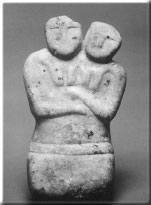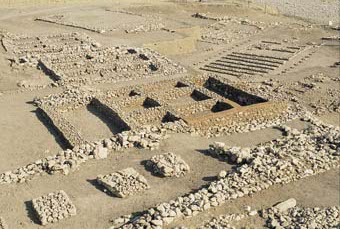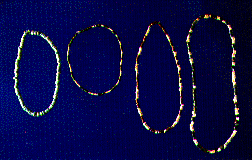|
Location:
Between Levant and Zagross, Turkey. |
Grid Reference:
38.217�
N. 39.717� E |

 �ay�n�:
(Cult Buildings). �ay�n�:
(Cult Buildings).
�ay�n� was excavated by Robert
Braidwood in the 1960s, as a joint project between the universities of
Chicago and Istanbul. It dates
back to at least 7,200 BC
(1)
The site provided the archaeological world with several
'first's' including animal husbandry, woven cloth, smelted copper
Terrazzo (stone pieces pressed into a cement base) floors and
several female figurines among the finds representing some of the
earliest traces of the Mother Goddess cult in the region.
(Map of
site - How to get there)
|
�ay�n�:
(�ay�n� Tepesi - Pron. 'chi-O-noo') |
�ay�n� is located forty kilometres
north-west of Diyarbakır, at the foot of the Taurus mountains. It lies
near the Bogazcay, a tributary of the upper Tigris River and the
Bestakot, an intermittent stream.
At 7,000 BC and earlier,
�ay�n�
presents certain discoveries that have forced us to rethink our prehistoric past.
The site
contains a large number of rectangular
stone buildings,
laid out in a grid-plan formation, as at
Nevali Cori.
Many of the buildings show evidence of having had special functions, for
example, the 'Flagstone' building has a floor made
entirely from large flagstones into which were
set megalithic stones (further
standing stones were also set in rows nearby), giving it the appearance of
the Valley temple,
Giza.
(1)
 The
area of the settlement consists of an occupation mound 200 meters in
diameter. There are five to six occupation levels that have been
discovered over the 600 years of occupation with the earliest even
pre-farming. The earliest levels do not include buildings, only
cooking pits. The second layer has a grill like foundation with pebble
pavement, parallel walls which probably supported wooden beams and
plaster-like floors. The third level had 9 x 10 meter buildings that
had terrazzo floors and homes constructed of white limestone cobbles
and crushed rock. This level also had a number of decorative
ornamentations included in the design. The fourth occupation level had
stone foundations and formed cell-like units with walls built of mud.
The final levels consisted of residential buildings arranged in a
rectangular fashion with a number of the buildings housing larger
rooms possibly used for public functions. It is believed that the
total population was between 100 and 200 people and the community
consisted of twenty-five to fifty buildings. The overall layout of the
village�s design showed a square in the center of the town with
rectangular shaped buildings and housing surrounding it. The majority
of the houses have the upper level built with mud bricks and the lower
level made out of stones. Some floors were made of plastered clay
while others were terrazzo floors. In addition to the buildings, there
are also indications that Cayonu had a number of storage facilities
probably used for grains. A deep cylindrical hole with remains of
clay and a domed structure was also discovered at this site and was
more than likely used for storage of various products.
(2) The
area of the settlement consists of an occupation mound 200 meters in
diameter. There are five to six occupation levels that have been
discovered over the 600 years of occupation with the earliest even
pre-farming. The earliest levels do not include buildings, only
cooking pits. The second layer has a grill like foundation with pebble
pavement, parallel walls which probably supported wooden beams and
plaster-like floors. The third level had 9 x 10 meter buildings that
had terrazzo floors and homes constructed of white limestone cobbles
and crushed rock. This level also had a number of decorative
ornamentations included in the design. The fourth occupation level had
stone foundations and formed cell-like units with walls built of mud.
The final levels consisted of residential buildings arranged in a
rectangular fashion with a number of the buildings housing larger
rooms possibly used for public functions. It is believed that the
total population was between 100 and 200 people and the community
consisted of twenty-five to fifty buildings. The overall layout of the
village�s design showed a square in the center of the town with
rectangular shaped buildings and housing surrounding it. The majority
of the houses have the upper level built with mud bricks and the lower
level made out of stones. Some floors were made of plastered clay
while others were terrazzo floors. In addition to the buildings, there
are also indications that Cayonu had a number of storage facilities
probably used for grains. A deep cylindrical hole with remains of
clay and a domed structure was also discovered at this site and was
more than likely used for storage of various products.
(2)
Mehmet �zdogan:
'In �ay�n� from the earliest monumental buildings, or special buildings it
is clear that they were doing something with some kind of liquid. As for
the earliest one, the Flagstone Building, it is certain that the floor
was polished and even in order to get some kind of flooding, and also in
the Sandstone Building there was a water channel going through it, and
the Terrazzo Building also had a kind of channel drainage. So was it
blood, or water or wine? It is difficult to say, but considering the
presence of the Skull Building it seems more the nastier end of the
story than the nicer end. Also in �ay�n�, we had in one building these
parts of a burial � not a complete skeleton � intentionally put in a
clay coffin above the ground, with some tools associated. It was the
strangest grave we got and it must have had something to do with the
function of that building'. (3)
The
'Skull' building - This structure
was 7m x 7.9m in size and has a round asp at one end. In two small
ante-chambers, archaeologists unearthed roughly 70 skulls, a figure which
was brought up to 295 eventually. A large chamber was also discovered that
contained a one-ton cut and polished stone block, which, along with the
discovery of a large flint knife makes it almost certain that the stone
acted as an 'offering table'.
'Microscopic analysis of the alter stone's
smooth surface revealed a high residue of blood that was found to come
from Aurochs, Sheep and
Human beings. There can be little doubt what this implies. The Skull
building was not only used for strange ancestral rites but also human
sacrifice'
(1)
Article: Anthropologists have extracted the blood
of humans, sheep and an extinct form of cattle from the surface of a stone
slab at an approximately 10,000-year-old agricultural village in Turkey.
Analysis of haemoglobin in the samples leaves them with intriguing clues and
questions about the ritual activities of early farmers. The polished slab
lies among the remains of a structure known as the �skull building,� which
contains more than 90 human skulls and several complete and partial human
skeletons.
�We don�t know exactly what was going on
in the skull building, but human and animal blood was abundant on the slab,�
says Andree R. Wood of the University of Chicago�s Oriental Institute. �It
reinforces an argument for at least its occasional use for the cutting up of
humans as well as of animals.�Human sacrifice is one possibility, or human
bodies may have been carted to the building after death and placed on the
slab for some type of pre-burial ritual. The skulls show no evidence of
decapitation.
Blood from the slab, dated with an
advanced technique called accelerator mass spectroscopy radiocarbon dating (SN:
12/16/89, p. 388), is about 9,000 years old, say Wood and Thomas H. Loy of
the Australian National University in Canberra.
Initial work at the slab identified human
and sheep blood, as well as the blood of an unknown, nonhuman species. The
team later obtained blood from bone fragments of an extinct cattle species
unearthed at the site and found that its haemoglobin crystals matched those
of the unknown species taken from the slab. This is the first identification
of the blood of an extinct species, they say.
After analyzing the blood, the researchers
excavated from the building a number of skulls and horns belonging to the
extinct cattle. They also uncovered a large flint knife whose blade held
traces of cattle and human blood. Wood says it may have been used in human
sacrifices or mortuary rituals, but she notes that toolmakers� blood often
ends up on sharp tools as a result of accidental cuts.
Ritual activity at Cayonu remains largely
a mystery, says Robert J. Braidwood of the Oriental Institute. Nonetheless,
he says, the cultural complexity hinted at by the skull building and other
structures at the site strengthens his �gut feeling� that humans crossed the
threshold to a village-farming life more than 10,000 years ago'.
Ref: (http://mathildasanthropologyblog.wordpress.com)
The discovery of woven cloth -
�ay�n�
was also the site of the earliest known of piece
of cloth, 'which was found still wrapped around an antler...it is 9,000 years
old and it thought to be a linen fabric, woven from locally grown
flax. (1)
'Archaeologists excavating [the
site] in 1988 found a puzzling, calcium-encrusted piece of material
clinging to what was probably the handle of a bone tool. Microscopic
analysis of the find, which measures about 3 inches by 1.5 inches, now
identifies it as the earliest known fragment of cloth, scientists
announced last week'.
'Several radiocarbon dates
obtained from artifacts found near the cloth place it at around 9,000
years old. Previously, the oldest examples of prehistoric cloth --
ranging from 8,000 to 8,500 years old -- came from another Turkish
site and an Israeli cave'.
"The uses of textiles are
innumerable, and it's hard to say how the Cayonu people employed
cloth," says Gillian Vogelsang-Eastwood of the National Museum of
Ethnology in Leiden, the Netherlands. Vogelsang-Eastwood, one of the
few archaeologists who specialize in the study of ancient textiles,
identified the Cayonu find as cloth.She suspects the fabric served as
a grip for the bone handle, which was fashioned out of an antler.
Ref: (http://findarticles.com)
'It
was not clear whether flax was domesticated originally for its
oil-bearing seeds, the source of linseed oil, or for its fibrous
stem, or if people had both uses in mind from the start.
To recover linen fibers from
the stem of the flax the people at Cayonu would have had to soak it
in a river or pond. This leaves the flax supple and golden blond,
which Dr. Barber points out is the origin of the poetic image of
"flaxen hair." In this state, the fibers can be separated and
twisted into a kind of rough thread.
As far as archeologists can
tell, the people at Cayonu were already using cloth for clothing,
for bags to carry food and perhaps for covering the dead. Dr.
Vogelsang-Eastwood speculated that the excavated piece might have
been used as a rag to get a better grip on the antler handle. Dr.
Hole, though, said it was more likely that it was the preserved
piece of the cloth bag that had held the antler.
Pottery and figurines have been
the best sources of knowledge about early clothing. The oldest known
figurines, about 20,000 years old and found in Eastern Europe and
Russia, showed early human hunters dressed in hooded garments made
of animal skins. The so-called Venus statuettes of that period show
women in skimpy skirts of twisted cords, which they might have
slipped into to welcome their men home from the hunt.
About 7,500 years ago, images
on pottery show people wearing more substantial cloth skirts, but
with nothing above the waist. There is no firm evidence of people
wearing fitted clothes until the Iron Age, in the first millennium
BC'.
Ref: (http://query.nytimes.com)
Metallurgy - �ay�n�
is believed to have been the main bead producing centre during the
early-Neolithic period. Archaeologists discovered four early copper items at
�ay�n�, dated at 7,200 BC - two pins, one bent fish-hook and a reamer or awl -
showing that its inhabitants were already proficient at this time.
�ay�n�
is the location of the earliest known hammered copper objects, (craftsmen
produced oval-shaped copper beads) and smelted copper and bronze objects for
at least 7,000 years.
A number of artifacts
of great value have been unearthed at Cayonu including stone tools of flint
and obsidian along with copper pins which indicate evidence of the earliest
know use of metal tools. Also, hammered native copper has also been
discovered in conjunction with other artifacts. Clay pottery has been found
including stone vessels and two small clay models of houses. Impressed or
incised bone pieces have also been found which may be indications of art,
numerical counters or an early experiment in writing. (2)
(Other Prehistoric Turkish sites)
|

 The
area of the settlement consists of an occupation mound 200 meters in
diameter. There are five to six occupation levels that have been
discovered over the 600 years of occupation with the earliest even
pre-farming. The earliest levels do not include buildings, only
cooking pits. The second layer has a grill like foundation with pebble
pavement, parallel walls which probably supported wooden beams and
plaster-like floors. The third level had 9 x 10 meter buildings that
had terrazzo floors and homes constructed of white limestone cobbles
and crushed rock. This level also had a number of decorative
ornamentations included in the design. The fourth occupation level had
stone foundations and formed cell-like units with walls built of mud.
The final levels consisted of residential buildings arranged in a
rectangular fashion with a number of the buildings housing larger
rooms possibly used for public functions. It is believed that the
total population was between 100 and 200 people and the community
consisted of twenty-five to fifty buildings. The overall layout of the
village�s design showed a square in the center of the town with
rectangular shaped buildings and housing surrounding it. The majority
of the houses have the upper level built with mud bricks and the lower
level made out of stones. Some floors were made of plastered clay
while others were terrazzo floors. In addition to the buildings, there
are also indications that Cayonu had a number of storage facilities
probably used for grains. A deep cylindrical hole with remains of
clay and a domed structure was also discovered at this site and was
more than likely used for storage of various products.
(2)
The
area of the settlement consists of an occupation mound 200 meters in
diameter. There are five to six occupation levels that have been
discovered over the 600 years of occupation with the earliest even
pre-farming. The earliest levels do not include buildings, only
cooking pits. The second layer has a grill like foundation with pebble
pavement, parallel walls which probably supported wooden beams and
plaster-like floors. The third level had 9 x 10 meter buildings that
had terrazzo floors and homes constructed of white limestone cobbles
and crushed rock. This level also had a number of decorative
ornamentations included in the design. The fourth occupation level had
stone foundations and formed cell-like units with walls built of mud.
The final levels consisted of residential buildings arranged in a
rectangular fashion with a number of the buildings housing larger
rooms possibly used for public functions. It is believed that the
total population was between 100 and 200 people and the community
consisted of twenty-five to fifty buildings. The overall layout of the
village�s design showed a square in the center of the town with
rectangular shaped buildings and housing surrounding it. The majority
of the houses have the upper level built with mud bricks and the lower
level made out of stones. Some floors were made of plastered clay
while others were terrazzo floors. In addition to the buildings, there
are also indications that Cayonu had a number of storage facilities
probably used for grains. A deep cylindrical hole with remains of
clay and a domed structure was also discovered at this site and was
more than likely used for storage of various products.
(2)